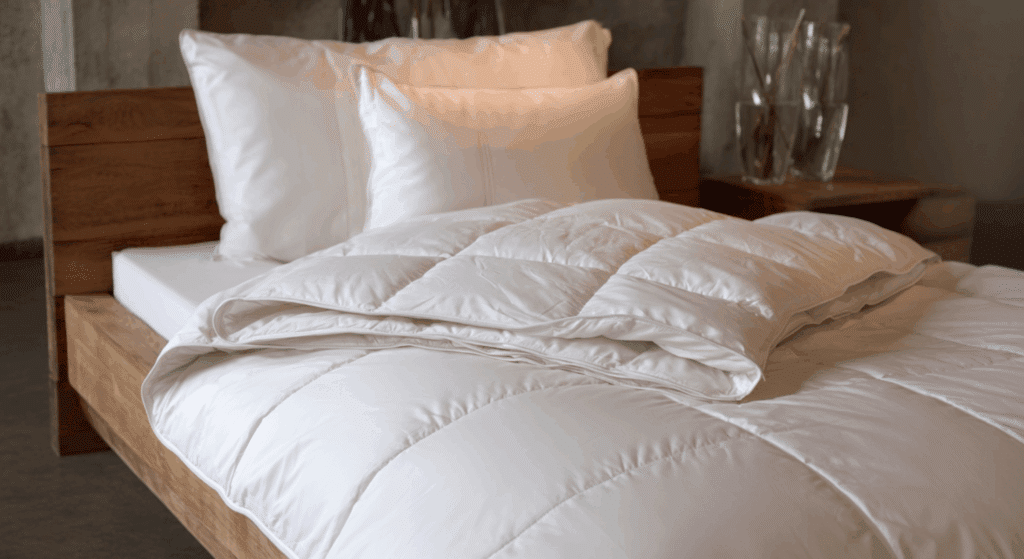I used to think buying bedding was simple, until I had to choose between duvet covers vs. comforters. I remember standing there, unsure what the difference even was, and wondering if it really mattered.
If you’re feeling that way right now, you’re not the only one. These two options look alike at first, but once you understand how they work and what they’re made for, the choice becomes much clearer.
You’ll learn how each one is structured, how much effort it takes to keep clean, and which one best fits your sleep style and space.
If you want bedding that fits your routine, not just your bed, this guide will walk you through what actually matters, without the extra noise.
What Most People Get Wrong About Duvets and Comforters
Most people think duvets and comforters are the same thing. I used to think that too. But once you learn the difference, it’s actually pretty simple.
The confusion usually starts with the names. In the U.S., many people use the word “comforter” for almost any fluffy blanket.
In other places like Europe, the word “duvet” is more common. Add in some unclear ads and mixed-up labels, and no wonder we all get confused.
Stores often throw both terms around without explaining much. This makes it hard to know what you’re really buying. So people guess or just buy whatever looks nice.
But here’s the thing: once you understand what sets them apart, choosing the right one becomes much easier. You’ll know what fits your routine, your bed, and how much work you want to put into keeping it clean.
Duvet vs. Comforter: What’s the Difference?
You’ve probably seen both on store shelves or online, but it’s not always clear what sets them apart. Before you choose one, it helps to understand exactly what each one is and how it works.
What is a Duvet?

A duvet is a soft, thick blanket that goes inside a duvet cover, kind of like a pillow goes inside a pillowcase.
The duvet itself is usually plain white or off-white and filled with a warm material, such as down, feathers, or synthetic fibers. You don’t use it by itself.
You tuck it into a duvet cover, which can be taken off and washed. That’s one of the big reasons people like duvets: you don’t have to wash the whole thing, just the cover.
When picking a duvet, what’s inside matters just as much as how it looks. The fill affects how warm it is, how heavy it feels, and how easy it is to clean. Here are the most common fill options:
- Down: soft feathers from ducks or geese; very warm and lightweight.
- Feathers: regular feathers; cheaper but heavier than down.
- Synthetic: made from polyester; great if you have allergies or want an easier wash.
- Wool or cotton: more breathable, often used in natural or eco-friendly duvets.
Pros and Cons of a Duvet System
Like anything, duvets come with ups and downs. Here’s a quick look at what’s good and what might bug you about using a duvet and cover system:
| Pros | Cons |
|---|---|
| Easy to wash the cover | Filling can bunch up inside |
| Change the look with new covers | Takes time to stuff it properly |
| Lightweight and breathable | Some covers don’t stay in place |
| Good for all seasons | Might slide around in the night |
A duvet works best when paired with the right cover. You can switch covers for different seasons or styles. And if you like a clean, simple setup, a duvet might be the better choice.
What is a Comforter?

A comforter is a thick, padded blanket that’s ready to use right out of the package. It doesn’t need a separate cover.
Everything is sewn together, the soft outer fabric and the warm filling inside. You just throw it on your bed and you’re done.
Comforters are often sold in sets with matching pillow shams or sheets. That’s one reason many people like them; they’re easy to buy and look good without extra effort.
Structure and Material
Comforters are usually filled with:
- Down: warm and light, but can be pricey.
- Down alternative: polyester fill that mimics down; great for allergy sufferers.
- Cotton or wool: natural options, less common in ready-made comforters.
The outer fabric is often made of cotton, microfiber, or polyester blends, and it’s all stitched together to keep the fill in place.
Pros and Cons of a Comforter
Comforters are simple and ready to go, but they aren’t perfect for everyone. Here’s a quick breakdown of the good and the not-so-good:
| Pros | Cons |
|---|---|
| Ready to use out of the box | Harder to wash the whole thing |
| Usually part of a bedding set | Style can’t be changed easily |
| No stuffing or extra setup | Can wear out faster after washing |
| Good choice for quick makeovers | Not as flexible for all seasons |
Comforters are great if you want something simple that looks nice without extra steps. But if you like changing things up or want easier cleaning, a duvet might be better for you.
Key Differences Between Duvet and Comforter
Duvets and comforters may seem alike at first, but they’re actually built quite differently.
The way they’re made, used, and cared for can really change your daily routine, especially when it comes to cleaning or switching up your room’s style.
If you’re not sure which one fits your lifestyle better, this side-by-side table can help you see the main differences quickly:
| Feature | Duvet | Comforter |
|---|---|---|
| Structure | Insert + removable cover | All-in-one piece, sewn shut |
| Maintenance | Cover needs regular washing; insert is rarely washed | The whole thing must be washed, which can be tricky |
| Style Options | Easy to change covers for a new look | Limited to the design it came with |
| Cost & Lifespan | It may cost more upfront, but the cover helps it last longer | Usually cheaper, but can wear out faster |
| Warmth & Fluffiness | Often fluffier, adjustable based on insert type | Medium fluff; warmth is fixed |
| Cleaning & Storage | Cover is easy to wash and fold; insert stores easily | Bulky to clean and store |
| Ideal Climate Use | Great for all seasons with different covers or inserts | Best for mild or steady temperatures |
As you can see, duvets offer more flexibility, especially if you like to switch things up or need something that works year-round. But if you want something low-effort and simple, a comforter might be all you need.
It really comes down to how much time you want to spend on upkeep and how often you like changing your bedding style.
Duvet vs. Comforter: Which is Better for You?
Choosing between a duvet and a comforter isn’t just about looks or price; it’s about how you sleep, how much time you want to spend on care, and what kind of space you’re working with.
Let’s look at who each one is best for:
1. For Hot Sleepers

If you tend to wake up feeling sweaty or throw the blanket off at night, a duvet will likely work better for you.
Duvets give you more control over warmth because you can choose lighter inserts and breathable covers made from cotton or linen.
Some even come with cooling features. Comforters, on the other hand, are all stitched together, and that means they usually hold more heat with fewer ways to adjust.
For someone who sleeps hot, that can be uncomfortable. So, if you’re a hot sleeper, a duvet can help you stay cooler without tossing and turning all night.
2. For Cold Sleepers

If you’re someone who’s always chilly and needs an extra-warm blanket, both a duvet and a comforter can help, but they work differently.
Duvets filled with down or wool can keep you warm without being too heavy. You can also switch out the insert depending on how cold it gets.
Comforters, while not quite as flexible, still offer plenty of warmth and don’t need much setup. If you want something simple that stays cozy, a comforter might be all you need.
But if you want the ability to adjust the thickness or change it through the seasons, a duvet gives you more options.
3. For Minimal Maintenance

If you don’t want to deal with extra work, a comforter is the way to go. It’s one piece—no covers, no inserts, and no fuss. You just toss it on your bed and you’re done.
With a duvet, you’ll need to take the cover off and wash it from time to time. You also have to make sure the insert stays in place and doesn’t bunch up, which can be annoying if you’re always in a rush.
So if you like to keep things easy and quick, especially when making the bed or doing laundry, a comforter is the better fit.
4. For Style Lovers

If changing up the look of your bedroom is important to you, a duvet is the clear winner. You can swap out covers whenever you want a new style without buying a whole new blanket.
This makes it easy to match the seasons, follow trends, or just try something different. Comforters don’t offer this same freedom. If you want a new color or design, you usually have to buy a brand-new one.
So, for those who enjoy switching up colors or styles often, duvets are the better choice.
5. Seasonal and Lifestyle Guide

When it comes to weather and living space, both duvets and comforters have their place.
In winter, a duvet with a thick insert can keep you warm and cozy, while in summer, switching to a lighter insert makes it easier to stay cool.
Comforters, on the other hand, tend to be more fixed in how warm they are. That’s fine in mild climates, but they may feel too hot or too cold in areas with bigger seasonal changes.
Overall, think about your space, your habits, and the seasons where you live. If you like things simple and don’t want to fuss with parts, a comforter makes sense. If you care more about comfort, changing looks, and adjusting to the weather, a duvet offers more freedom.
Here’s a small table to wrap it up and help you see the fit at a glance:
| Your Need | Best Choice |
|---|---|
| You sleep hot | Duvet |
| You sleep cold | Duvet or Comforter (both work) |
| You want less upkeep | Comforter |
| You like changing styles | Duvet |
| You live in a dorm/apartment | Comforter |
| You’re setting up a guest room | Duvet |
| You need year-round comfort | Duvet |
This quick table shows that duvets offer more flexibility, while comforters win when you want something easy and done. Think about what matters most to you, then go with what fits your life.
Tips to Clean your Duvet & Comforter
Taking care of your duvet or comforter the right way can make it last longer and feel better. Here are some easy tips to keep your bedding fresh, clean, and in good shape:
- How to wash a duvet cover: Wash it like you would your sheets, once every week or two. Use cold or warm water and a gentle cycle. Avoid bleach, and tumble dry on low or hang it up to air dry.
- When to clean inserts: You don’t need to wash the inserts as often; just once or twice a year, unless something spills. Always check the care label before washing. Some need dry cleaning, while others can go in the machine.
- How to store them properly: Make sure the duvet or comforter is fully dry before storing it. Use a breathable cotton bag, not plastic, and keep it in a cool, dry place. This helps stop mold or smells.
- Preventing clumping or flattening: Fluff your duvet or comforter every few days to keep the filling evenly distributed. When drying, toss in a couple of clean tennis balls or dryer balls to break up clumps.
Good care keeps your bedding clean and soft, helping it stay comfy for years. A little effort goes a long way.
Common Mistakes to Avoid
Even though duvets and comforters are simple to use, people often make small mistakes that can shorten their lives or make them less comfortable.
Knowing what not to do like this can save you time, effort, and money later:
- Using a duvet without a cover: This makes it wear out faster and harder to clean. Always use a cover to protect the insert.
- Choosing the wrong size insert: If the insert is too small or too big for the cover, it won’t sit right or stay in place.
- Not securing ties or buttons: Forgetting to tie the corners or close the buttons can cause the insert to bunch up inside the cover.
- Overwashing bulky comforters: Washing too often can damage the filling and stitching. Spot clean or use a cover instead.
- Ignoring care labels: Each blanket has different washing and drying needs. Not following them can ruin the fabric or cause shrinkage.
Avoiding these simple mistakes helps your bedding last longer, stay cleaner, and feel more comfortable every night.
Conclusion
I didn’t realize how much easier sleep could be until I understood the difference between duvet covers vs. comforters. Once I figured out what worked best for my space and habits, bedtime became more comfortable.
You’ve now got the same info, so take a minute to think about what fits your daily routine and what kind of upkeep you’re okay with.
Now that you’ve got the basics down, you can choose what actually works for you, not just what looks good online. One last thing to keep in mind: little upkeep goes a long way in keeping your bedding fresh and comfy.
Want more simple tips like this? Check out other blogs for more easy, helpful ways to improve your sleep space!









